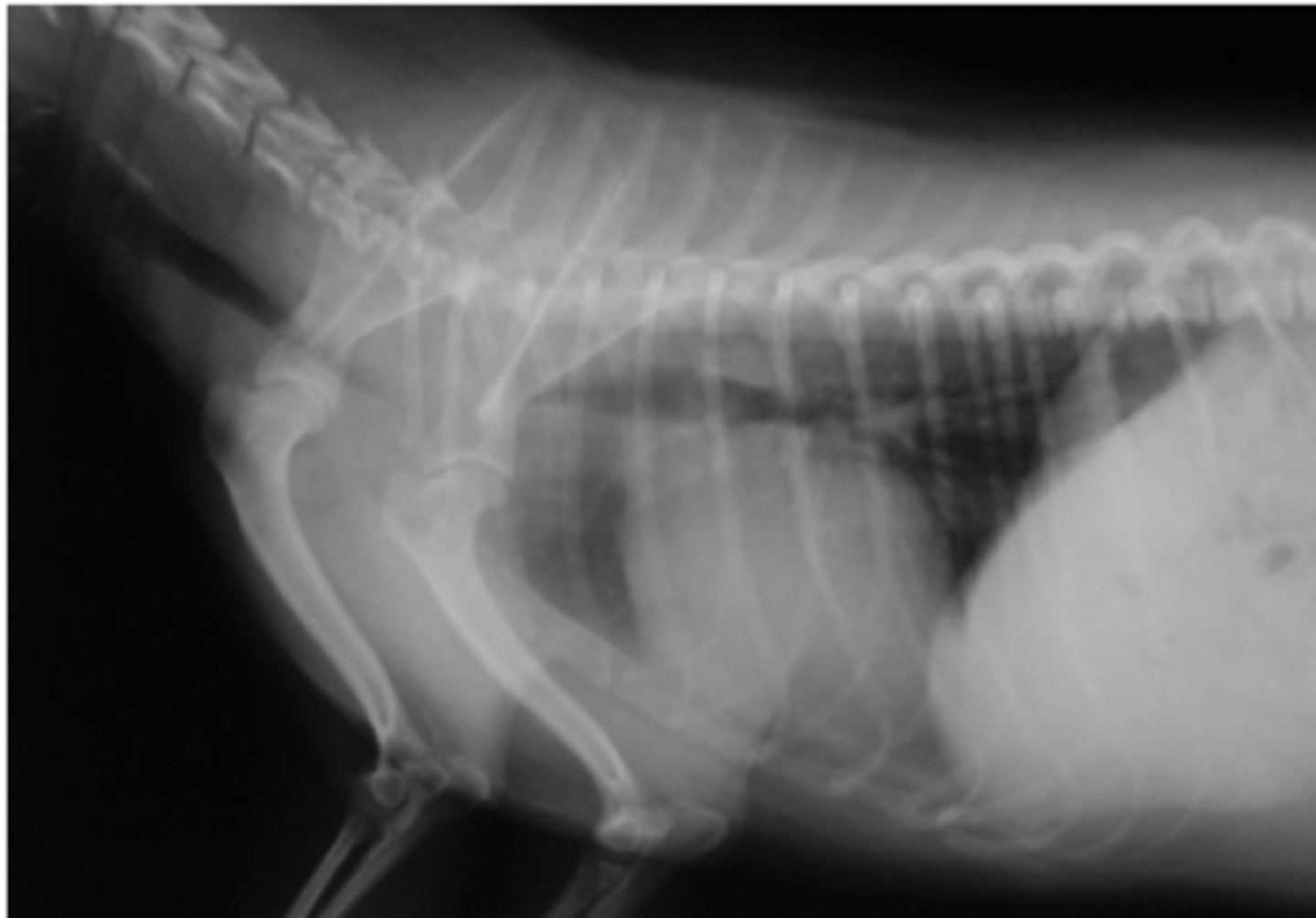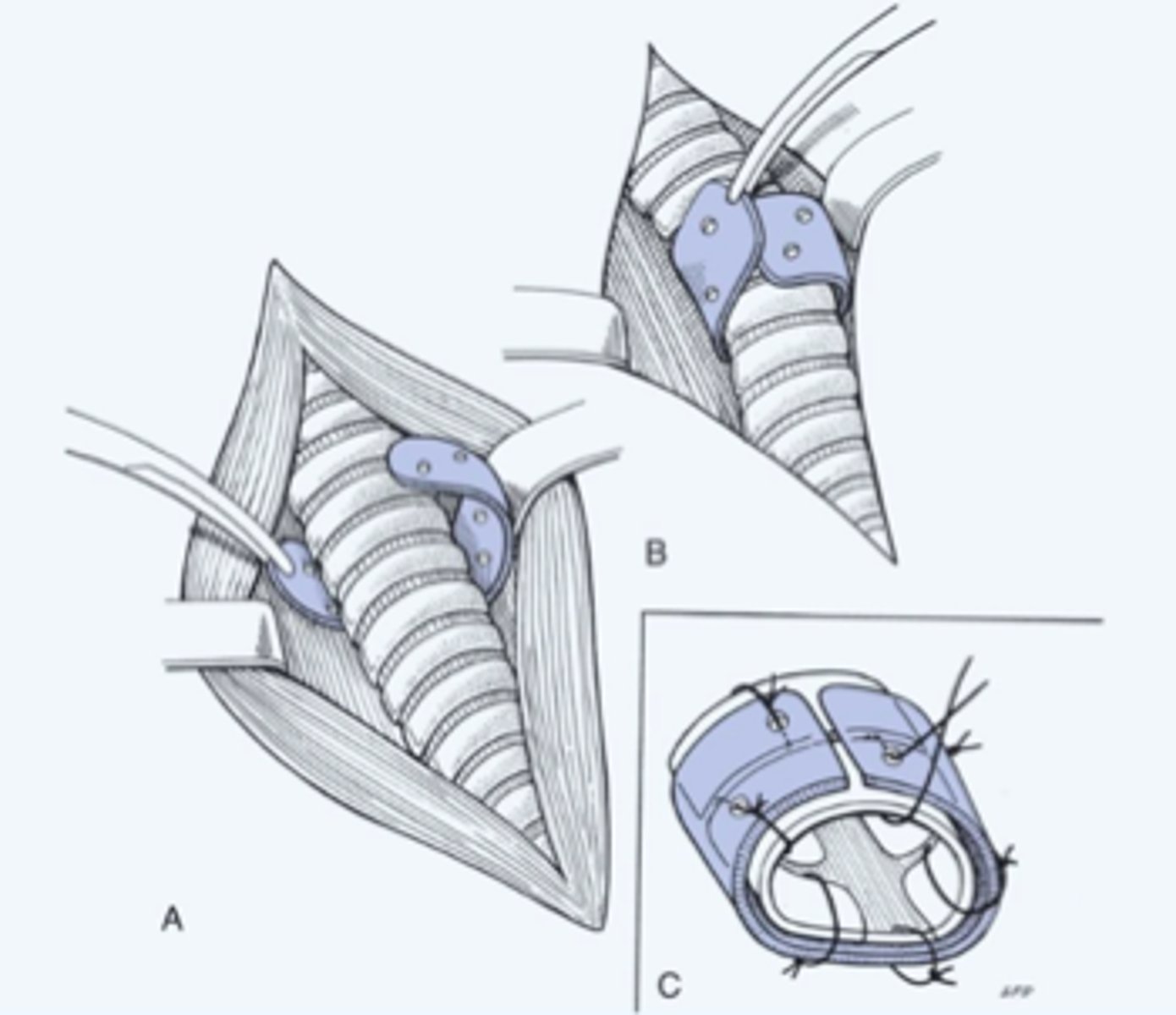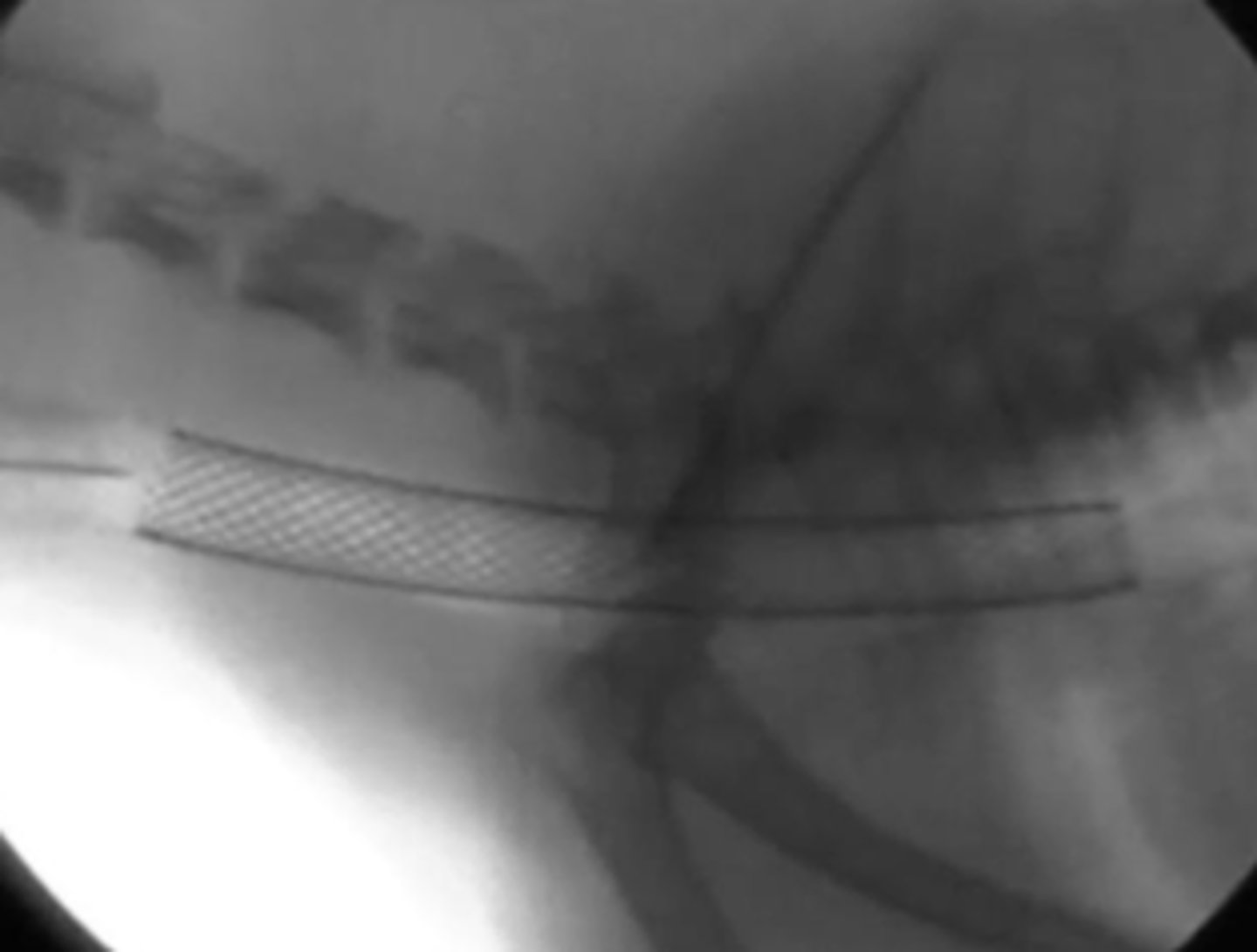12 tracheal collapse
1/38
There's no tags or description
Looks like no tags are added yet.
Name | Mastery | Learn | Test | Matching | Spaced |
|---|
No study sessions yet.
39 Terms
tracheal collapse
this is a form of tracheal obstruction caused by cartilage flaccidity and flattening
the cause is unknown and probably multifactorial
what is the problem with knowing the pathophysiology of tracheal collapse?
top down/bottom up aka dorsoventral direction (NOT SIDE TO SIDE)
in what way does the trachea collapse?
INSPIRATION: cervical and thoracic inlet collapse
EXPIRATION: intrathoracic collapses
what is tracheal collapse like on inspiration and expiration?
thoracic inlet
which part of the trachea is most susceptible to tracheal collapse?
COUGHING
what becomes an important tracheobronchial clearing mechanism with tracheal collapse?
typically TOY and mini dogs, though it CAN HAPPEN in large dogs (it is more associated with trauma/deformity/masses in them)
what is the signalment like for tracheal collapse?
Because tracheal collapse in large breed dogs should NOT BE EQUATED with tracheal collapse in toy breed dogs = consider what is causing it
In larger dogs, tracheal collapse is usually associated with trauma, deformity, and masses. Why do we care?
GOOSE HONK COUGH
What is the CLASSIC SYMPTOM for tracheal collapse?
Tracheal collapse
(though common differentials are kennel cough, laryngeal paralysis/collapse, etc)
A dog presents with flaccid tracheal cartilages with prominent lateral borders on palpation of the cervical trachea, though the dog breaks into paroxysmal coughing on palpation. What is your first thought?
1. obesity (50%)
2. laryngeal paralysis (20%)
3. systolic heart murmur (33%)
4. dental disease (40%)
Name some common concurrent problems with tracheal collapse:
Intrathoracic tracheal collapse
A patient with tracheal collapse shows soft end-expiratory snapping together of the tracheal wall. What is this?
Cervical trachea
which part of the trachea will collapse on inspiration?
thoracic (aka intrathoracic) trachea
which part of the trachea will collapse on expiration?
DIAGNOSTIC IMAGING (though it may require multiple modalities and bronchoscopy) = collapsed lumen, bronchiectasis or cardiopulmonary disease in some
what should you do to diagnose tracheal collapse? what will it look like?
tracheal collapse (which is not the same as "microtrachea", which will be a more "uniform" collapse throughout)
what is happening here?

do laryngoscopy at the same time as tracheoscopy because laryngeal paralysis is present in 30% of dogs with tracheal collapse
what should you do at the same time as tracheoscopy when evaluating a dog for tracheal collapse? why?
4
how many grades are there of tracheal collapse?
grade 1
which grade of tracheal collapse shows a relatively normal tracheal cartilage anatomy, with up to 1/4 luminal diameter collapse
grade 2
which grade of tracheal collapse shows mild to moderate flattening of the tracheal cartilages, with up to 1/2 luminal diameter collapse
grade 3
which grade of tracheal collapse shows severe flattening of the tracheal cartilages, with up to 3/4 loss of luminal diameter
grade 4
which grade of tracheal collapse shows complete obstruction, with 100% tracheal lumen collapse
1. kennel cough
2. brachycephalic syndrome
3. laryngeal collapse/paralysis
4. bronchitis
5. tracheobronchitis
6. allergies
7. heartworm disease
8. hypoplastic trachea
name a few differential diagnoses for tracheal collapse:
when there is less than 50% tracheal lumen collapse, aka grades I and II you can medically manage
when can you medically manage tracheal collapse (and should think about medically managing instead of jumping straight into surgery)?
weight loss, harness instead of collar, nonsmoking atmosphere, medicinally (antitussive aka cough suppressant)
name a few ways you can medically manage tracheal collapse
response to medical therapy is usually transient/temporary, and the disease typically progresses aka remind the owner the problem will progress and the patient will not remain stable forever
what do you need to remind the owner when medically managing tracheal collapse?
severe clinical signs, over 50% reduction of tracheal lumen (aka grade III and IV)
when should you jump to surgically treating tracheal collapse?
support tracheal cartilages and trachealis muscle while preserving as much of the segmental blood and nerve supply to the tracheal as possible
what is the goal of surgically treating tracheal collapse?
extraluminal ring prostheses and endoluminal stenting
name some surgical techniques for treating tracheal collapse:
surgical treatment of collapsing trachea (aka extraluminal ring protheses and endoluminal stenting)
which surgical procedure aims to support tracheal cartilages and trachealis muscle while preserving as much of the segmental blood and nerve supply to the tracheal as possible
FALSE: these are ADVANCED SURGICAL PROCEDURES and it is recommended to REFER
true or false: extraluminal ring prosthesis and endoluminal stent placement to surgically manage tracheal collapse should be done by general practitioners as the dog's condition is likely critical at that point.
extraluminal ring prosthesis
what is happening here, where you retract the sternohyoid and expose the trachea, pass the ring around the trachea and suture in place between holes and thru the cartilage?

endoluminal stent placement
what is happening in this minimally invasive procedure, where you place in a stent and let it expand?

under general anesthesia using tracheoscopy or fluoroscopy
how should you perform endoluminal stent placement to correct collapsing trachea?
because constant movement at that point often leads to early fracture of the stent
why should you be careful about placing an endoluminal stent near the thoracic inlet when correcting tracheal collapse?
nasal insufflation of O2, glucocorticoids, mucolytics, antibiotics, antitussives, bronchodilators, cage rest 3-7 days, tracheoscopy 1-2 months post op
name a few post-op things you can do to care for animals recovering from endoluminal stent or extraluminal ring prosthesis:
NOTHING: after surgery, the quality of life is improved for most patients, but neither SURGERY NOR STENTS CURE THE CONDITION
what cures tracheal collapse?
prognosis dependent on concurrent respiratory problems (laryngeal paralysis/collapse, bronchial disease) rather than the location or severity of tracheal collapse
what is the prognosis dependent on with tracheal collapse post surgery patients?
regardless of treatment type, the presence of mainstem bronchi collapse is associated with shorter survival times
regardless of treatment type, the presence of WHAT is associated with shorter survival times for post op tracheal collapse patients?